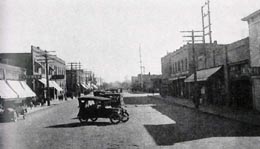On June 5, 1917, the work of paving the streets of four main blocks in the central business area begins in Sunnyside. William Bright "Billy" Cloud (1870-1959), recently elected mayor of Sunnyside on a platform that included the promise to pave Sunnyside's mud-filled thoroughfares, is the impetus behind this major capital improvement project.
Billy Cloud's Legacy
Billy Cloud, born in New Jersey, owned the Valley Clothing Store in Sunnyside and had lived in Washington since 1894.
A triumphant article in The Sunnyside Sun announced the beginning of the paving project:
"The work of paving the streets of Sunnyside has started. The workmen and materials are arriving daily and the six-inch iron pipe for the water mains, which is to be put down, is already strung along the streets. The trees, which long have been regarded as landmarks, are being taken down and hauled away. The steam roller has also arrived and is being put in shape to do its part. The city counsel decided at the last meeting to place the old water mains, which are to be taken up and replaced with the iron pipes, under ground on 7th Street as the pipe will not keep when not under ground" ("Actual Work...").
Remarkable Rapidity
By the middle of July, The Sunnyside Sun described the paving work as proceeding with "a systematic rapidity that to the onlooker is remarkable. All the iron water mains are in place with 2000 feet of wooden main laid and 2500 feet of drain tile down and covered. At the gravel pit an 25 horsepower motor pulls the gravel up by means of a drag line and a scraper in the hopper, from where it goes to the grader and from there the large rocks are returned to the crusher and is then carried back to the line from which it is loaded onto the wagons. The big scraper carries 20 cubic feet of gravel at each load, and makes a trip every three minutes. Four men and the foreman are required at the pit. The company has taken every precaution to protect their men from the dangerous machinery at this works. Twenty teams, two-thirds four horses, are hauling the gravel and sand for the bitulithic mixture which will be put on the streets. The company is expecting its mixing plant to arrive this week, and this will require the services of more men ... . Two thousand barrels of bitumen have arrived and are on the side track of the NP [Northern Pacific] where the mixing plant is to be established" ("Construction Co...").
Further paving work was done on 6th Street. Edison Avenue was paved from the railroad station to the eastern town limit. Total cost for the project was $62,629.45.
Sunnyside historian Roscoe Sheller's 1952 history of the town states:
"Coming as it did when the town's streets were all but impassable because of the deep mud that no amount of rock and gravel seemed to improve, that pavement, extending its welcoming fingers to the edges of Sunnyside, can be named today as one of the most important moves in Sunnyside's history. Billy Cloud, the driving force that pushed it through to its successful end, merits the undying gratitude of Sunnyside" (Courage and Water, p. 198).

